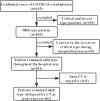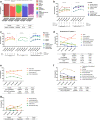Chest CT Features of 182 Patients with Mild Coronavirus Disease 2019 (COVID-19) Pneumonia: A Longitudinal, Retrospective and Descriptive Study
- PMID: 33067768
- PMCID: PMC7566584
- DOI: 10.1007/s40121-020-00352-z
Chest CT Features of 182 Patients with Mild Coronavirus Disease 2019 (COVID-19) Pneumonia: A Longitudinal, Retrospective and Descriptive Study
Abstract
Introduction: The evolution of computed tomography (CT) findings in patients with mild coronavirus disease 2019 (COVID-19) pneumonia has not been described in detail. A large-scale longitudinal study is urgently required.
Methods: We analyzed 606 CT scans of 182 patients. The dynamic evolution of CT scores was evaluated using two staging methods: one was divided into 10 periods based on decile intervals, and the other was one stage per week. Moreover, the latter was used to evaluate the dynamic evolution of imaging performance. A published severity scoring system was used to compare findings of the two methods.
Results: In the dynamic evolution of 10 stages, the total lesion CT score peaked during stage 3 (9-11 days) and stage 6 (17-18 days), with scores = 7.19 ± 3.66 and 8.00 ± 4.57, respectively. The consolidation score peaked during stage 6 (17-18 days; score = 2.72 ± 3.07). In contrast, when a 1-week interval was used and time was divided into five stages, the total lesion score peaked during week 3 (score = 7.3 ± 4.15). The consolidation score peaked during week 2 (score = 2.54 ± 3.25). The predominant CT patterns differed significantly during each stage (P < 0.01). Ground-glass opacities (GGO), with an increased trend during week 3 and beyond, was the most common pattern in each stage (33-46%). The second most common patterns during week 1 were GGO and consolidation (24%). The linear opacity pattern with an increased trend was the second most common pattern during week 2 and beyond (21-32%).
Conclusions: The total lesion score of mild COVID-19 pneumonia peaked 17-18 days after disease onset. The consolidation scores objectively reflected the severity of the lung involvement compared with total lesion scores. Each temporal stage of mild COVID-19 pneumonia mainly manifested as GGO pattern. Moreover, good prognosis may be associated with increases in the proportions of the GGO and linear opacity patterns during the later stage of disease.
Keywords: COVID-19; Pneumonia; SARS-CoV-2; Tomography; X-ray computed.
Figures





Similar articles
-
[Spatial and temporal distribution and predictive value of chest CT scoring in patients with COVID-19].Zhonghua Jie He He Hu Xi Za Zhi. 2021 Mar 12;44(3):230-236. doi: 10.3760/cma.j.cn112147-20200522-00626. Zhonghua Jie He He Hu Xi Za Zhi. 2021. PMID: 33721937 Chinese.
-
Temporal changes of CT findings between non-severe and severe cases of COVID-19 pneumonia: a multi-center, retrospective, longitudinal Study.Int J Med Sci. 2020 Sep 21;17(17):2653-2662. doi: 10.7150/ijms.51159. eCollection 2020. Int J Med Sci. 2020. PMID: 33162793 Free PMC article.
-
Fangcang Shelter Hospital in Wuhan: A radiographic report on a cohort of 98 COVID-19 patients.Int J Med Sci. 2020 Jul 30;17(14):2125-2132. doi: 10.7150/ijms.48074. eCollection 2020. Int J Med Sci. 2020. PMID: 32922173 Free PMC article.
-
Similarities and Differences of Early Pulmonary CT Features of Pneumonia Caused by SARS-CoV-2, SARS-CoV and MERS-CoV: Comparison Based on a Systemic Review.Chin Med Sci J. 2020 Sep 30;35(3):254-261. doi: 10.24920/003727. Chin Med Sci J. 2020. PMID: 32972503 Free PMC article.
-
Comparison of the computed tomography findings in COVID-19 and other viral pneumonia in immunocompetent adults: a systematic review and meta-analysis.Eur Radiol. 2020 Dec;30(12):6485-6496. doi: 10.1007/s00330-020-07018-x. Epub 2020 Jun 27. Eur Radiol. 2020. PMID: 32594211 Free PMC article.
Cited by
-
Lung abnormalities on computed tomography of Vietnamese patients with COVID-19 and the association with medical variables.IJID Reg. 2024 Jan 19;10:183-190. doi: 10.1016/j.ijregi.2024.01.006. eCollection 2024 Mar. IJID Reg. 2024. PMID: 38351902 Free PMC article.
-
Longitudinal Chest CT Features in Severe/Critical COVID-19 Cases and the Predictive Value of the Initial CT for Mortality.J Inflamm Res. 2021 Mar 25;14:1111-1124. doi: 10.2147/JIR.S303773. eCollection 2021. J Inflamm Res. 2021. PMID: 33790623 Free PMC article.
-
Impact of persistent D-dimer elevation following recovery from COVID-19.PLoS One. 2021 Oct 28;16(10):e0258351. doi: 10.1371/journal.pone.0258351. eCollection 2021. PLoS One. 2021. PMID: 34710097 Free PMC article.
-
An Evaluation of Type 1 Interferon Related Genes in Male and Female-Matched, SARS-CoV-2 Infected Individuals Early in the COVID-19 Pandemic.Viruses. 2024 Mar 20;16(3):472. doi: 10.3390/v16030472. Viruses. 2024. PMID: 38543837 Free PMC article.
-
The Role of Lung Ultrasound in SARS-CoV-19 Pneumonia Management.Diagnostics (Basel). 2022 Jul 31;12(8):1856. doi: 10.3390/diagnostics12081856. Diagnostics (Basel). 2022. PMID: 36010207 Free PMC article.
References
-
- World Health Organization Coronavirus Disease (COVID-19) Dashboard. 2020. https://covid19.who.int/. Accessed 7 July 2020.
-
- Wu Z, McGoogan JM. Characteristics of and important lessons from the coronavirus disease 2019 (COVID-19) outbreak in China: summary of a report of 72314 cases from the Chinese Center for Disease Control and Prevention. JAMA. 2020;323(13):1239–42. - PubMed
LinkOut - more resources
Full Text Sources
Miscellaneous

